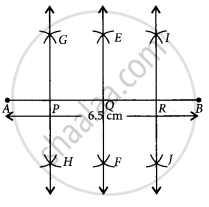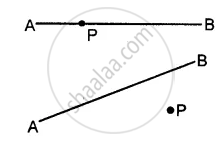Advertisements
Advertisements
प्रश्न
Draw a line segment of length 6.5 cm and divide it into four equal parts, using ruler and compasses.
उत्तर

Steps of construction:
(i) Draw a line segment AB = 6.5 cm.
(ii) With A and B as centres and radius more than `1/2` (AB), draw arcs one on each side of AB, these arcs cuts each other at E and F.
(iii) Join EF, which cuts AB at Q.
(iv) With centres A and Q and radius more than `1/2` AQ, draw arcs one on each side of AB, these arcs cuts each other at G and H.
(v) Join GH, which cuts AB at P.
(vi) Similarly, with centres B and Q and radius more than `1/2` (BQ), draw arcs one on each side of AB, these arcs cuts each other at I and J.
(vii) Join IJ, which cuts AB at R.
(viii) Now, point P, Q and R divide the line segment AB in four equal parts.
Thus AP = PQ = QR = RB.
APPEARS IN
संबंधित प्रश्न
In each of the following, draw perpendicular through point P to the line segment AB :
(i)

(ii)

(iii)

Draw a line segment AB = 5.5 cm. Mark a point P, such that PA = 6 cm and PB = 4.8 cm. From point P, draw a perpendicular to AB.
Draw a line segment of given length and construct a perpendicular bisector to line segment using scale and compass
7 cm
Draw a line segment of given length and construct a perpendicular bisector to line segment using scale and compass
10.4 cm
Draw a line segment of given length and construct a perpendicular bisector to line segment using scale and compass
58 mm
The line of symmetry of a line segment is the ______ bisector of the line segment.
Only one perpendicular bisector can be drawn to a given line segment.
Draw an angle of 60° using ruler and compasses and divide it into four equal parts. Measure each part.
Draw a line segment of length 12.8 cm. Using compasses, divide it into four equal parts. Verify by actual measurement.
With `overline"PQ"` of length 6.1 cm as diameter, draw a circle.
